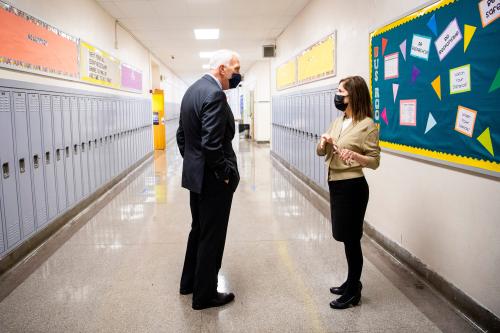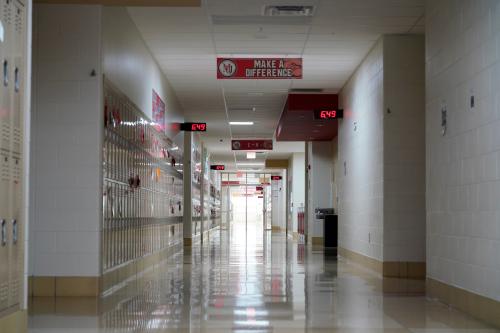Though kids are learning this year, many have fallen even further behind grade level. Our new report—which draws from a national survey of school districts—reveals how good intentions have collided with vexing realities. As new COVID-19 outbreaks and anxiety over health concerns kept kids and teachers home, and as politics roiled small-town and suburban schools, district leaders found themselves squeezed by the conflicting pressures set by new state mandates and parent demands.
Top leaders of six school systems spoke about their specific challenges as part of in-depth interviews conducted for the report. Under promises of anonymity, superintendents and other district leaders were eager to speak about the struggles they could see in schools and classrooms, as well as their concerns about the welfare of children, teachers, and principals. They were also forthright about the need for changes in how schools operate, including new ways to use time, money, and teacher skills; to identify and help kids who struggle; and to make greater use of community resources for learning and student support.
Thoughtful plans meet harsh realities
Many school and district leaders had hoped to accelerate learning in 2021-22 by teaching kids at grade level and providing just-in-time help with ideas or skills lost to pandemic absences. But uneven classroom attendance—among students and teachers alike—prevented steady progress.
One major district leader reported that half of high school students were missing too many days to pass their courses. Others said one or more schools closed every week for lack of teachers. Still others said that student and teacher absences forced constant changes in teacher-student pairings. Leaders in two districts said teachers and students learned bad habits during the pandemic. They said their teachers needed to stop using canned materials and instead take advantage of in-person settings for discussion and student problem-solving.
System leaders also reported unprecedented levels of stress among children and adults, which interfered with their ability to focus on academics. “The level of maturing and engagement among students is not there,” one district administrator told us. “It’s not just a child who has lost ground in reading, it’s that they don’t even know how to function in a classroom with other kids.”
Teacher absences and resignations were doubly disruptive in the five of our six districts where the pool of substitutes had dried up. Though most teachers were staying on the job, many fewer people were looking for teaching jobs. Districts were forced to poach from one another, and some were using federal windfalls to sweeten salaries and draw teachers away from other nearby districts.
Big-city districts in our sample reported few problems with culture-war politics. But smaller and less urban ones were heavily distracted by them. Vaccine mandates, masking directives (and prohibitions on masking directives), and conflicts over curriculum stressed school boards and strained previously smooth relations with parents and among teachers.
With few new tools to address these surprising challenges, many top administrators think restoring pandemic losses will require major changes in how schools and classrooms work, and they worry that schools will not be able to do it alone. At a time when unity and concerted work is essential, district leaders lamented the loss of normal levels of parent support and staff divisions over work issues, safety concerns and politics. Some also fight their own fatigue and loss of joy in work.
By October, teachers were telling one superintendent, “I can’t do this. I thought I could, but I’m not mentally strong enough right now to do this. It’s exhausting.” The superintendent added, “Now you’ve got people who are done, and it is only October. Our burnout is full on.” Another noted,
“Everybody’s feeling stressed. Corks are popping, the space and grace is evaporating.”
Solutions require tenacity and creativity
Yet district leaders and other educators are determined and resilient. As the 2021–22 school year winds down, many are rallying. One big, urban district is building new partnerships with community agencies for tutoring and student support. Several others, including a big charter network, are using the pandemic as an opportunity to rethink their expectations for what is taught every year, how they measure student learning and feed it back into instructional plans, and how the district tailors its actions to meet the needs of individual schools.
Most districts we studied are helping teachers adapt to new modes of instruction that require some to present material and others to provide repeat or catch-up help. Three—including ones in a big city, a suburban town, and a charter network—are working hard to wean both teachers and students off habits of split attention that can work in an online environment but not in classrooms.
On teaching practices, one district administrator reflected:
“I think one of the unintended consequences is an overreliance on strategies that you may have had to do when you were teaching remotely that you no longer have to do. And so there’s a little bit of this strategic abandonment that we’re working through. … The math problem isn’t a COVID problem. The math problem is that we’re asking kids to listen and watch the adults do math, not doing the math themselves.”
These problems will be with us for a while
In the wake of a crisis that directed attention to district-level actions and policy, leaders are trying to find the right balance between top-down priority setting and school-level discretion. Many are turning away from state or nationally normed testing and relying on school-level data and homegrown assessments. Some district leaders have stopped trying to standardize practices across their districts, and they are empowering individual schools to deal with their own combination of student needs and teaching challenges.
In other words, superintendents struggle with the fact that everything from course content to the school schedule and the teacher contract were built for another era. Such mismatches lead to stress and frustration, not only for leaders but also teachers and parents.
These challenges won’t just go away; they could persist as long as children in first grade today remain in school. Can the individuals now leading districts and schools adapt? RAND Corporation, our research partner, conducted a fall 2021 survey of district leaders and found that only half of superintendents said they were likely to stay in their jobs for the long term. If many quit, who will replace them, and how will successors get the skills they need?
From what we heard last fall, these and other questions are likely to remain unresolved or even get more difficult as we enter summer and begin the 2022-23 school year in fall. The traditional bonds of confidence between parents and schools, and among educators, are strained. Many urban districts are losing students to homeschooling, charters, and private and small-town schools, and they’re facing big losses in state financing. This will make it even more unlikely that school districts can meet student needs with the schools, teachers, and methods they have.
The solutions will require new modes of spending, performance measurement, and school oversight, as well as much greater flexibility in teacher hiring, training, and work. Superintendents and school-board leaders can’t make these changes all by themselves. They’ll need serious help and new thinking from governors, state legislators, the federal government, and philanthropy.







Commentary
Restoring pandemic losses will require major changes in schools and classrooms, superintendents say
May 13, 2022